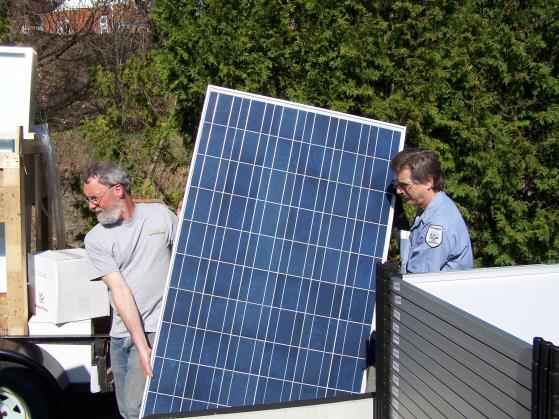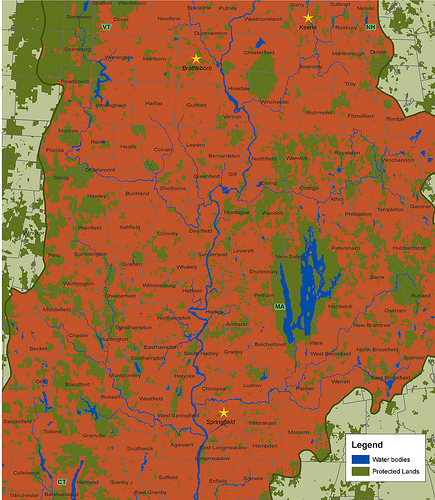A major goal of Greenfield Mayor Christine Forgey has been to build a Wal-Mart or a similar “big box” store on an area of open land that’s too far from downtown to easily reach on foot. On April 21, in a primary election, Forgey was voted out of office. In June, voters will choose from two candidates for mayor.
“I was glad the mayor was voted out,” said John Ward, co-owner of the Solar Store www.GreenfieldSolarStore.com on Fiske Avenue in downtown Greenfield. “Open space doesn’t have to be paved just because it’s open space.”
John Ward (left). photo by Eesha Williams
Long-time smart growth advocate and Greenfield resident Al Norman www.sprawl-busters.com said he hopes the site of the proposed big box store—on the French King Highway near Route 2—would become a park. “But I’m open to compromise, to seeing a small discount store there – not the kind of big box the mayor wanted that would have been bigger than the Wal-Marts in Northampton and Hadley,” he said. “Forgey fired longstanding conservation commission members and replaced them with pro-big box people.”
The site is home to several wetlands. The topsoil has been stripped off much of the site by developers. To turn it back into a forest would require a purchase, and forest regeneration work, by the local, state or federal government, or by a private organization like the Trust for Public Land www.tpl.org. The Trust is a national group with an office in Northampton. It has successfully completed many land protection and forest regeneration projects.
In interviews on April 22, both candidates for mayor expressed similar views on the proposed big box store. Both said they have heard from many Greenfield residents who now drive to the Wal-Mart in Northampton, Mass., or Hinsdale, N.H., to do their shopping, and they want a discount store in Greenfield.
Bill Martin said, “The market will dictate the highest and best use of the site… I support labor unions… I also support downtown revitalization.”
Wal-Mart and most other big box corporations are strongly anti-union. Details on Wal-Mart’s record on unions are at www.WalMartWatch.com and www.WakeUpWalMart.com. Experts say big box stores are one of the main reasons for the decline of downtowns in rural areas of the U.S.
The other mayoral candidate, Al Siano, said, “I support the Greenfield Mercantile effort to create a discount store downtown. I haven’t heard about the proposal to create a park on the site where the big box store is now proposed. I’d like to hear more about that. Unions help workers get a fair living wage and benefits. I support them. I’m a huge proponent of revitalizing Main Street. I want to make our downtown as vibrant as Brattleboro’s. I also support protecting open space. But I am not anti-big box.”
The Mercantile’s web site is at www.GreenfieldMercantile.com.
(On another issue, Siano said, “I want to get passenger train service to Greenfield.” Amtrak currently serves Brattleboro, Amherst and Springfield; freight trains pass through Greenfield.)
In 2001, a Greenfield-based nonprofit group run by Native Americans, Friends of Wissatinnewag, bought land directly across the street from the site of the currently proposed big box store. Part of the land the group bought was a Native American burial ground. The group donated to the state a conservation easement guaranteeing that the site would never be developed. The Friends also sold 21 acres of the land to the U.S. Fish & Wildlife Service to be protected. Details are at www.wissatinnewag.org.
Steve Alves is an award-winning documentary filmmaker in Greenfield. His web site is at www.TalkingToTheWall.com. He said he opposes the proposed big box store and noted that the site is “surrounded on three sides by wetlands and is on top of one of the biggest aquifers in Greenfield. The entire site floods every year.” Alves said Greenfield resident Howard Clark was instrumental in the success of Friends of Wissatinnewag. Alves said Clark has sent letters to the town opposing the current big box proposal. Clark’s phone number is unlisted but is available from Alves.
-----------
Map by the Trust for Public Land, 2006. This map shows the Pioneer Valley section of the Connecticut River watershed. Land outside the watershed is light green, meaning streams in that area do not flow to the Connecticut River. Dark green land has been protected from development. Red land is vulnerable to being paved with McMansions, Wal-Marts, parking lots, roads and ChemLawns. Please click on the map to enlarge it.


Post new comment